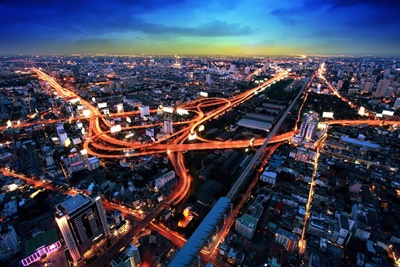Article by: Asst.Prof. Suwan Juntiwasarakij, Ph.D., MEGA Tech Senior Editor
เป็นเวลาเกือบสามศตวรรษแล้วที่การปฏิวัติอุตสาหกรรมได้เริ่มขึ้น แรงขับเคลื่อนทางเศรษฐกิจ การเมือง และเทคโนโลยีได้มาบรรจบกันดึงดูดให้ผู้คนหลั่งไหลเข้าสู่ชุมชนเมือง จวบถึงเวลาเปลี่ยนผ่านเข้าสู่ศตวรรษที่ยี่สิบเอ็ดพบว่าชุมชนเมืองรอบโลกนั้นมีการเติบโตด้วยอัตราเร็วสูงที่ใครก็ไม่สามารถคาดคิดได้

โอกาสที่มีอยู่มากมายเหลือล้นในชุมชนเมืองนี้เอง ที่เป็นแรงจูงใจทำให้ผู้คนย้ายถิ่นฐานไปยังเขตเมือง เพื่อแสวงหาคุณภาพชีวิตที่ดีกว่า ทั้งนี้ การก่อตัวของชุมชนเมืองที่เพิ่มขึ้นนี้ ทำให้เมืองเริ่มที่จะประสบกับความท้าทายในอนาคต ได้แก่ โครงสร้างพื้นฐาน ระบบสาธารณสุข และการจัดการทรัพยากรพลังงาน หนึ่งในความท้าทายขั้นวิกฤติ คือ ระบบการสัญจร อันเนื่องมาจากการสัญจรนี้เป็นตัวขับเคลื่อนการเติบโตทางเศรษฐกิจ

ข้อมูลจากดีลอยต์พบว่าหลายชุมชนเมืองทั่วโลกกำลังประสบปัญหาเส้นทางสัญจรที่เสื่อมประสิทธิภาพและระบบขนส่งที่คับคั่ง ในชุมชนเมืองที่แออัดที่สุดนั้น ผู้ขับขี่เสียเวลาประมาณ 100 – 200 ชั่วโมงเป็นอย่างต่ำต่อปีหรือสองถึงห้าสัปดาห์ต่อปีให้กับการจราจรที่ติดขัดอยู่บนท้องถนน เฉพาะในสหรัฐอเมริกานั้นพบว่าความเสียหายของโครงสร้างพื้นฐาน อันเป็นผลจากสภาวะการจราจรติดขัดนี้มีมูลค่าเกิน 5 แสนล้านดอลลาร์ต่อปีภายในปี 2040 ซึ่งส่งผลกระทบต่อจีดีพีของประเทศ

โครงการความคิดริเริ่มจำนวนมากได้ถือกำเนิดขึ้นเพื่อตอบสนองวิถีชีวิตและการเดินทางของสมาชิกในชุมชนเมือง ปรากฏการณ์ที่ได้เกิดขึ้นแล้ว คือ เม็ดเงินการลงทุนจำนวนมากได้กระหน่ำเข้าสู่อุตสาหกรรมการสัญจรอัจฉริยะ ทั้งนี้สำนักงานเทศบาลเมืองในหลายประเทศได้นำร่องการใช้เทคโนโลยีการสัญจรอัจฉริยะกันไปบ้างแล้ว นครลอนดอนใช้ประโยชน์จากข้อมูลปริมาณมหาศาลที่มาจากการสัญจรของพลเมืองในเครือข่ายการขนส่งมวลชนเพื่อนำมาสร้างระบบจัดการจราจรให้กับทั้งเมือง ระบบสั่งการกลางดึงข้อมูลจากรถบัส 9,200 คัน สัญญาณไฟจราจร 6,000 จุด และกล้องวงจรปิด 1,400 ตัว เพื่อปรับแต่งสัญญาณการจราจรให้คล่องตัวมากยิ่งขึ้น นครนิวยอร์คทดลองนำร่องเทคโนโลยีการสื่อสารระหว่างยานพาหนะ-ยานพาหนะ และ ระหว่างยานพาหนะ-โครงสร้างพื้นฐาน เพื่อเสริมสร้างความปลอดภัยแก่ผู้สัญจรบนท้องถนนและผู้เดินทางเท้าในย่านแมนฮัตตันและบรูคลิน นครหลวงอย่างเช่นโตเกียว ฟีนิกซ์ และสิงคโปร์ล้วนแต่ประสบความสำเร็จในการทดสอบรถแท็กซี่แบบไร้คนขับทั้งสิ้น

ในการใช้ประโยชน์จากเทคโนโลยีเกิดใหม่เหล่านี้อย่างเต็มที่เพื่อนำมาแก้ไขปัญหาอันยุ่งเหยิง เช่น ปัญหาการจราจร เมืองจำเป็นจะต้องมีระบบบูรณาการที่เพียบพร้อมเพื่อที่จะหลุดพ้นขีดจำกัดโครงสร้างพื้นฐานที่มีอยู่ ผลักดันให้การสร้างมูลค่าใหม่จากภาคส่วนที่เกี่ยวข้อง และเพาะบ่มสั่งสมความก้าวหน้าทางเทคโนโลยี กล่าวคือ เมืองจำเป็นต้องมีระบบปฏิบัติการจราจร (mobility operating system: mOS) แพลตฟอร์มที่บูรณาการเชื่อมต่อระบบโครงสร้างพื้นฐานทางกายภาพ (ถนนและราง) รูปแบบการขนส่ง (รถยนต์ส่วนบุคคล ระบบขนส่งสาธารณะ การแบ่งปันการขับขี่ และการแบ่งปันการปั่นจักรยาน) และผู้ให้บริการการขนส่ง (ตัวแทนจัดการระบบขนส่งสาธารณะ) ทั้งนี้ เพื่อสร้างแนวคิดการเสริมสร้างประสิทธิภาพทั้งระบบผ่านกลไกการเข้าสู่ดุลยภาพทางการตลาด

แพลตฟอร์มการสัญจรของเมืองสามารถสร้างสมดุลของอุปสงค์และอุปทาน อีกทั้ง ยังอำนวยสภาพและปริมาณการจราจรด้วยวิธีปรับแต่งแรงจูงใจระหว่างอัตราค่าโดยสายของแต่ละรูปแบบการเดินทาง-สถานที่ และการใช้เทคนิคทางพฤติกรรมศาสตร์ เช่น การวางแบบแผนทางพฤติกรรม และการสร้างแบบแผนทางสังคม อย่างไรก็ดีการสร้างและใช้งานระบบปฏิบัติการสัญจรได้อย่างเต็มรูปแบบนั้นอาศัยความอุตสาหะพยายามอย่างมากซึ่งกินเวลากว่าหลายปี ถึงกระนั้นก็ตามดอกผลที่เป็นรูปธรรมจะเกิดขึ้นทีละขั้นและเพิ่มพูนขึ้นบนรากฐานเดิมสู่ขั้นที่สูงขึ้นตามพัฒนาการและการเติบโตของระบบ เมืองที่จะใช้ระบบดังกล่าวนี้ ควรเริ่มต้นจากการทำความเข้าใจในการใช้สอยและบริหารจัดการโครงสร้างพื้นฐานที่มีอยู่ในชุมชนเสียก่อน ท้ายที่สุดก็จะไปสู่การบริหารจัดการรูปแบบคมนาคมขนส่งอื่นอันหลากหลายทั่วทั้งเมือง ลดการคับคั่ง เพิ่มการเข้าถึง ซึ่งจะเป็นหนทางไปสู่การเสริมประสิทธิภาพการเดินทางของทั้งระบบในภาพรวม

ตามที่กล่าวมานี้ อุปสรรคอันสำคัญต่อแพลตฟอร์มการสัญจรแบบบูรณาการ ดูเหมือนจะเป็นด้านการเมือง ด้านสังคม และด้านเศรษฐกิจมากกว่าที่จะเป็นด้านเทคนิค ในการสร้างแพลตฟอร์มการสัญจรดิจิทัลให้สำเร็จนั้น องค์กรปกครองชุมชนต้องก้าวข้ามเพื่อหลุดพ้นกรอบวิธีปฏิบัติติทางด้านนโยบายการจัดสรรงบทุนแบบเดิม และเก็บเกี่ยวใช้ประโยชน์จากนวัตกรรมเทคโนโลยีล่าสุดเพื่อสร้างแพลตฟอร์มที่สร้างความโปร่งใส สามารถทำงานร่วมกันได้ และสามารถเสริมประสิทธิภาพให้แก่เครือข่ายการคมนาคมขนส่งที่มีความแตกต่างและหลากหลายได้












